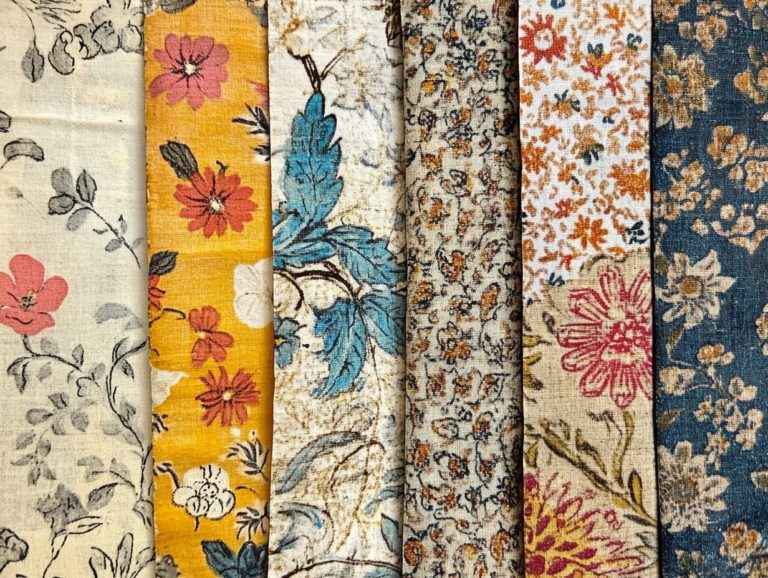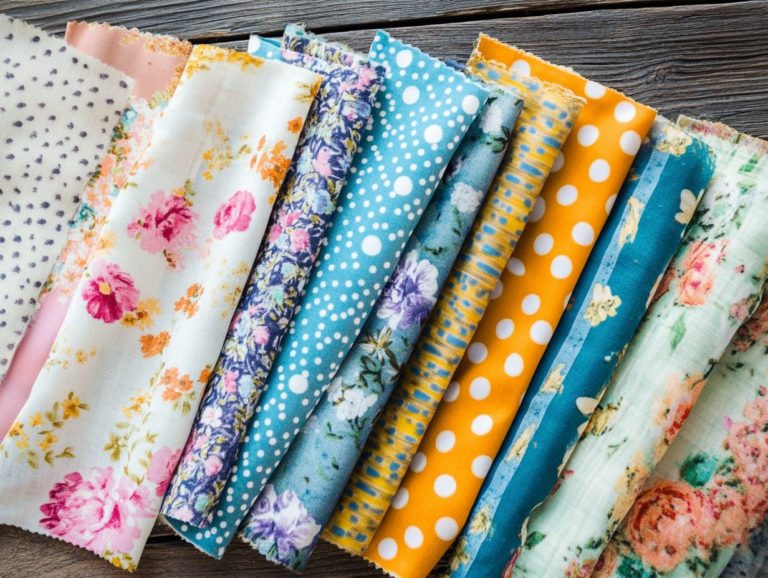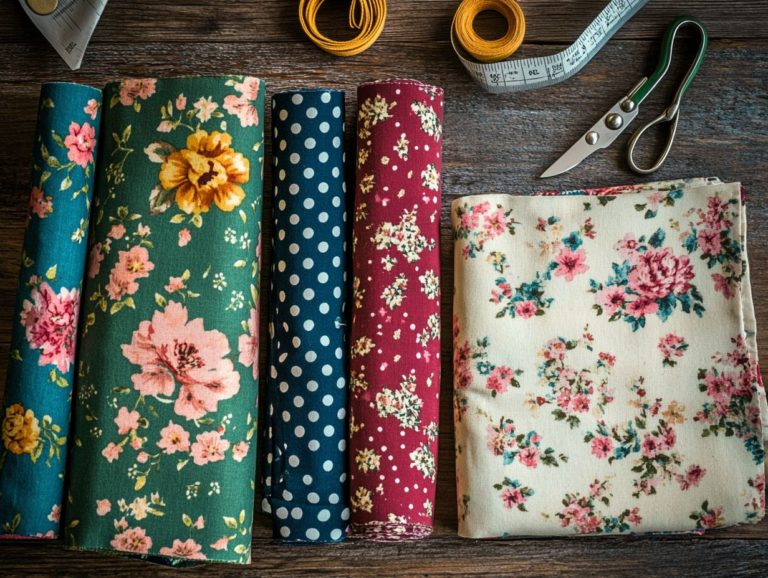Understanding Different Vintage Fabric Weaves
Vintage fabric weaves possess a rich history, each one narrating a unique story through its texture and design.
From the understated elegance of plain weave to the intricate artistry of jacquard, these fabrics not only captivate the eye but also exude timeless charm.
This article will guide you through various types of vintage fabric weaves, enabling you to recognize their distinct visual characteristics and textures.
You ll also find practical applications and essential care tips to help preserve their beauty for years to come.
Immerse yourself in the enchanting world of vintage fabrics and uncover their allure!
Contents
Key Takeaways:

- Vintage fabric weaves are the different patterns created during the weaving process, giving fabrics unique characteristics and uses.
- Plain, twill, satin, jacquard, and brocade are the most common types of vintage fabric weaves, each with its distinctive appearance and feel.
- When identifying vintage fabric weaves, look for visual characteristics and consider the fabric’s texture and drape. Proper care and use can ensure the longevity of these special fabrics.
What are Vintage Fabric Weaves?
Vintage fabric weaves embody a rich tapestry of textile artistry, showing many techniques and styles that have elegantly evolved over time.
From the robust construction of twill to the luxurious sheen of satin, each weave narrates a story steeped in artistry, culture, and innovation.
These fabrics’ aesthetic charm captivates many collectors in vintage fashion and costumes. Their unique textures and patterns offer a glimpse into historical styles and craftsmanship that continue to influence modern designs.
If you love intricate details, you ll adore jacquard weaves! Understanding these weaves is essential for appreciating the intricacies of vintage fabrics.
The intricate patterns elevate the visual allure of garments while underscoring the technological advancements of their eras. For example, twill s diagonal ribbing provides durability that was essential for everyday wear in the past, while satin’s smooth finish has long been synonymous with opulence in various periods of fashion history.
Modern textile designers often draw inspiration from these vintage weaves, creatively weaving their timeless characteristics into contemporary clothing.
By acknowledging the significance of these fabric weaves, you can truly appreciate their enduring impact on the evolution of fashion and the exquisite art of textiles.
Common Types of Vintage Fabric Weaves
Common types of vintage fabric weaves showcase a stunning array of techniques that emphasize the versatility and artistry of textiles. Each type is distinguished by its unique structure and pattern.
You ll find that plain weave is the simplest and most widely used, laying the foundation for countless fabrics.
On the other hand, twill weave creates those eye-catching diagonal patterns, celebrated for their durability and rich texture.
Satin weave, revered for its smooth surface and luxurious feel, makes fabrics like silk and acetate the epitome of desirability.
If you appreciate intricacy, jacquard weave offers stunning patterns, often adorned with small, intricate designs that capture the eye.
Then there s brocade, known for its opulent, raised designs, typically crafted from specialty fibers like linen and polyester, adding a touch of elegance to any collection.
Plain Weave
Plain weave is a foundational weaving technique that you ll easily recognize by its straightforward over-and-under structure. This results in a flat, uniform fabric that s not only durable but also remarkably versatile.
You ll often find it in materials made from cotton and linen, known for their excellent absorbency and breathability, making them perfect for everything from garments to home textiles.
The historical significance of plain weave is quite profound, with origins stretching back thousands of years, showcasing the brilliance of early textile artisans.
Its simplicity opens the door to a wide array of fabric weights and textures, ranging from lightweight cotton muslin to more robust materials ideal for upholstery.
What enhances the appeal of plain weave is its durability; it can easily withstand regular use and laundering.
The inherent absorbency of cotton woven in this manner makes it the go-to choice for anything from everyday clothing to luxuriously soft towels, firmly establishing its status as a staple in the textile industry.
Start exploring the world of vintage fabrics today and discover the endless possibilities they offer!
Twill Weave
Twill weave captivates with its signature diagonal pattern. This pattern results from the intricate weaving of threads, striking the perfect balance between texture and durability. It shines in fabrics like gabardine, a strong type of fabric that maintains its shape well. Gabardine makes an excellent choice for suits and outerwear.
The allure of twill weave isn t just skin-deep; it offers practical benefits as well. These include improved drape and resilience. Its density works harmoniously with various materials like cotton, wool, and synthetic fibers, lending remarkable versatility to the fabric.
In vintage fashion, the timeless elegance of twill is unmistakable. Classic garments evoke nostalgia while ensuring comfort and structure. Whether fashioned into tailored trousers or chic jackets, the distinctive qualities of this weave continue to hold a treasured spot in both contemporary and retro wardrobes.
Satin Weave
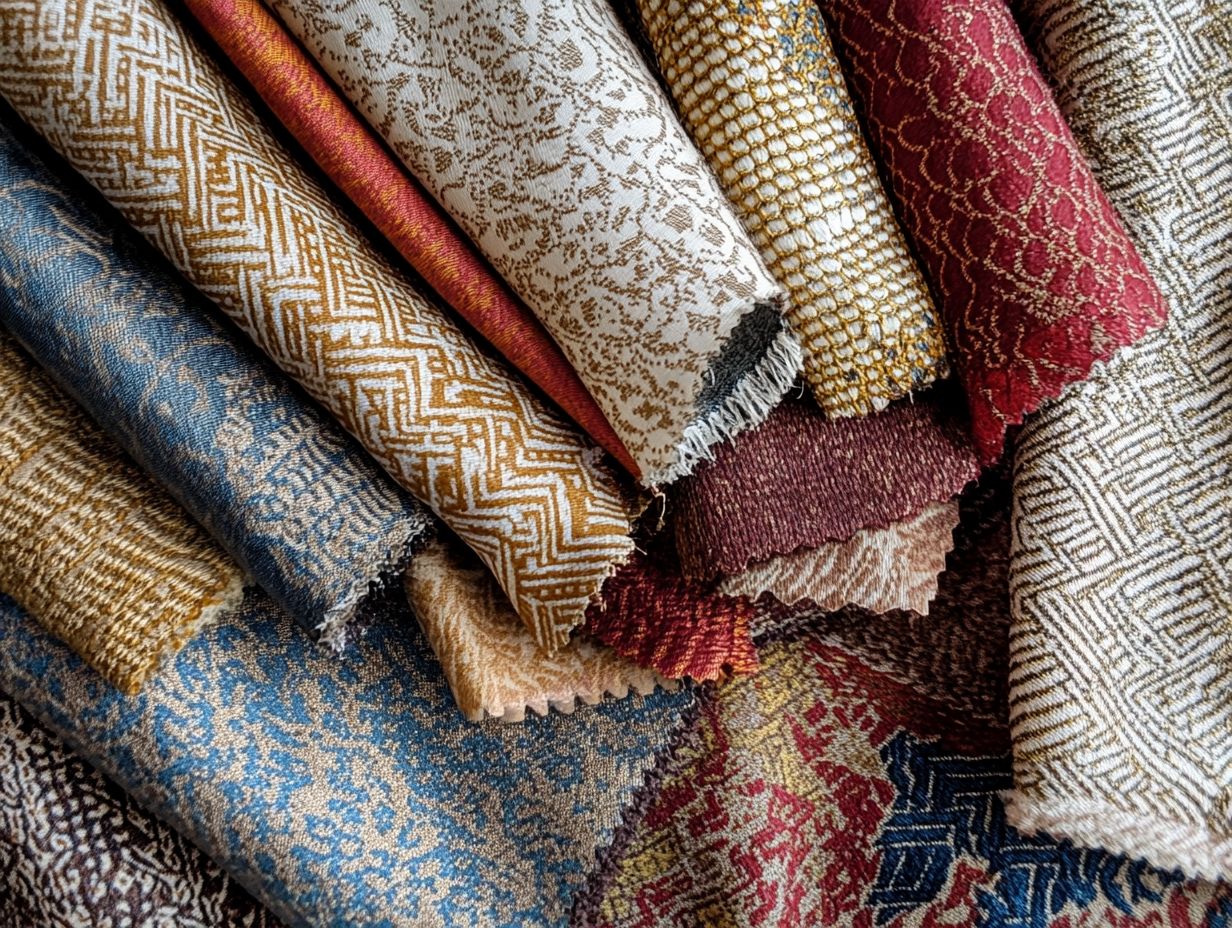
Satin weave is celebrated for its luxurious texture and lustrous surface. This result comes from a unique weaving technique that maximizes thread exposure on one side. Often crafted from silk or acetate, satin fabrics possess an aesthetic allure that has firmly established them as a staple in vintage fashion. They are particularly popular for evening wear and formal costumes.
The distinctive finishes of satin weave impart a smooth, reflective quality. This quality beautifully captures light, elevating garments to an exquisite level of elegance. This fabric has also adorned the gowns of bygone eras, infusing special occasions with an air of sophistication.
Beyond silk and acetate, modern variations are crafted from polyester and nylon. These materials expand the versatility of satin to applications ranging from sumptuous dresses to plush upholstery. The interlacing of fibers enhances the fabric’s sheen and contributes to its durability. This makes satin a preferred choice for both its beauty and practicality in vintage textiles.
Jacquard Weave
Jacquard weave is a marvel, renowned for its intricate patterns. These patterns are crafted on a specialized loom that allows complex designs to be woven directly into the fabric, rather than simply printed on its surface. Designers often use specialty fibers, offering an impressive array of textures and decorative possibilities in vintage textiles.
Emerging in the early 19th century, this innovative weaving method transformed fabric production. It established itself as a cornerstone in the textile world. Its historical significance shines through in royal garments and lavish home decor, showcasing its elite status.
Vintage fashion aficionados particularly cherish the bold designs characteristic of jacquard weave. These can feature everything from floral motifs to intricate damasks and striking geometric patterns. With fibers such as silk, cotton, and linen often in play, these luxurious textiles not only captivate the eye but also narrate a rich story of craftsmanship and elegance throughout the ages.
Brocade Weave
Brocade weave dazzles with its opulent designs. It showcases raised patterns often crafted from metallic threads or specialty fibers, creating a rich texture and lavish appearance. This luxurious fabric has become a hallmark of vintage fashion. It is frequently employed in formal garments and upholstery, embodying a sense of grandeur and sophistication.
Historically, brocade was meticulously woven on hand looms. This fabric was primarily reserved for royalty and the affluent elite, who adorned themselves in elaborate garments for significant events and celebrations. Brocade symbolizes cultural heritage and craftsmanship, capturing the artistry of textile production from diverse regions.
In contemporary fashion, designers have breathed new life into this exquisite weave. They integrate it into high-fashion collections, infusing modern silhouettes with a vintage allure. Fabrics such as silk and velvet are often associated with brocade, enhancing its royal connotation. This makes it a favored choice for evening wear, bridal gowns, and home d cor, all aimed at evoking an enduring elegance.
Discover the Beauty of Vintage Fabric Weaves
Identifying vintage fabric weaves requires a keen eye for various visual characteristics and tactile qualities that set each type apart. This enables enthusiasts and collectors to discern authenticity and craftsmanship.
Pay close attention to key aspects such as the texture of the fabric, its drape, and the overall construction of the weave. These elements provide valuable insights into the fabric’s age and origin, enhancing your appreciation of its unique history.
Visual Characteristics
Visual characteristics play a crucial role in identifying vintage fabric weaves. Each weave type boasts its own distinct patterns and textures that serve as telltale signs of authenticity. For instance, the subtle sheen of satin or the recognizable diagonal pattern of twill can set them apart from other fabric types.
When you inspect the finish, you’ll uncover additional clues. A heavy brushed texture often hints at cozy flannel, while a tightly woven damask (a type of fabric with intricate patterns) reveals smooth, intricate designs. Understanding the value of vintage fabrics can also aid in identification of variations like basketweave or gabardine.
Vintage patterns like houndstooth or paisley enhance your ability to recognize these fabrics. They often showcase rich colors and elaborate designs that embody their era. Patterns such as Prince-of-Wales check and seersucker also add to the aesthetic appeal.
By closely examining these visual cues including luster, thickness, and the drape of the fabric you can deepen your appreciation for the craftsmanship and history behind these unique textiles. Understanding construction and texture variations adds to your knowledge.
Texture and Drape
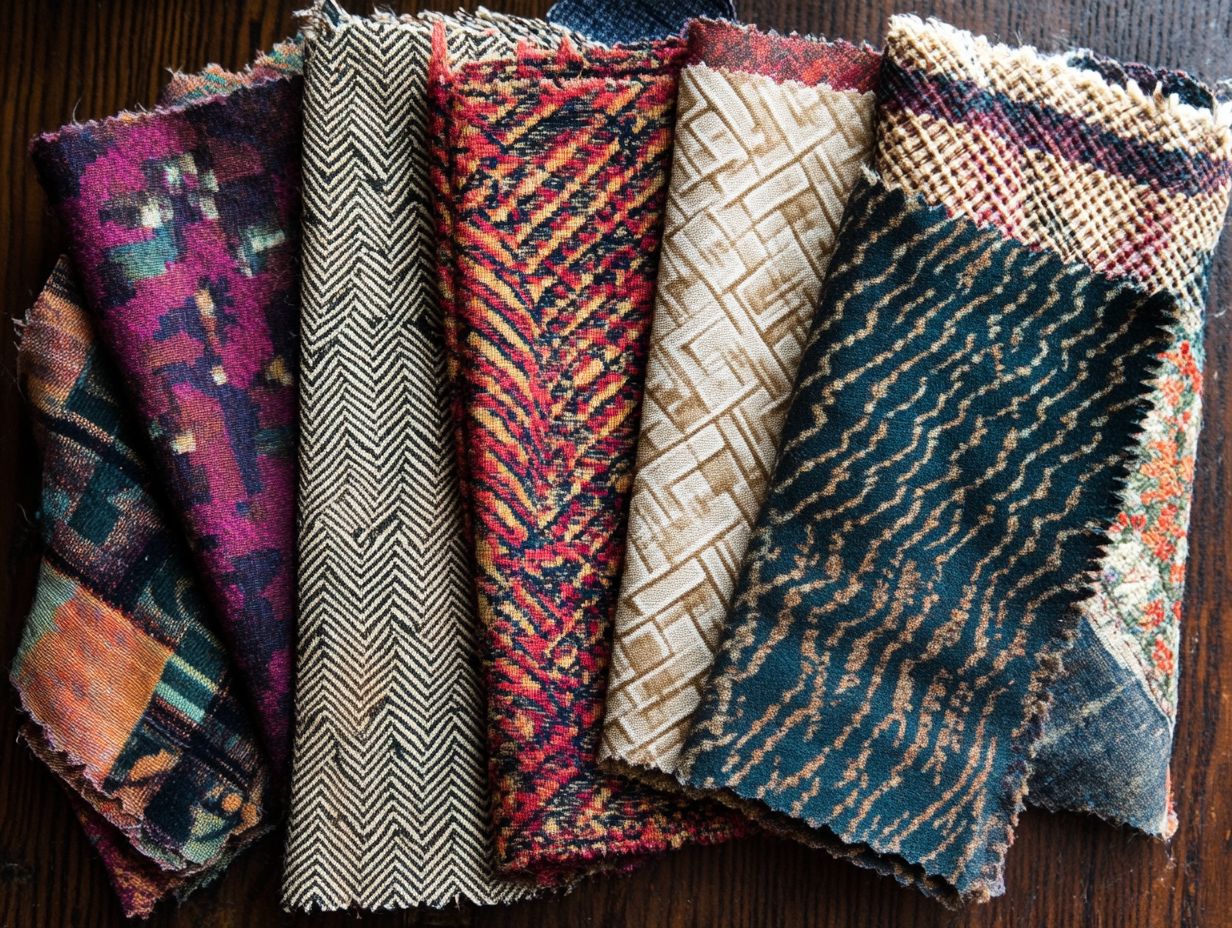
Texture and drape are vital when it comes to identifying vintage fabrics. They significantly impact how the material feels and falls. Fabrics with distinct textures like the smoothness of satin or the roughness of linen can provide clues about their weave type. The way they drape can reveal insights into their weight and structure.
When evaluating vintage textiles, pay close attention to how a fabric cascades or gathers. For instance, silk chiffon flows gently, while a heavier brocade maintains a more structured shape. This observation is crucial for determining the fabric’s intended use whether it was crafted for elegant gowns or everyday attire.
Running your fingers over the surface can help you identify unique characteristics, such as the subtle sheen of taffeta or the coarse texture of burlap. The density and surface detail of each fabric can also provide important clues.
Vintage items often display a variety of fabric treatments. Familiarity with these elements can sharpen your ability to distinguish authentic pieces from reproductions. Techniques like sewing or using technical sketches can enhance your understanding.
Uses and Care for Vintage Fabric Weaves
Vintage fabric weaves present a wealth of possibilities for fashion statements and exquisite home decor. However, they demand careful handling to safeguard their integrity and allure. Understanding the special benefits of various fabrics is essential.
Grasping the right care techniques is vital for preserving the quality of these cherished textiles, ensuring they continue to radiate vibrancy and serve their purpose beautifully. Each fabric type has its own unique requirements, from absorbency to durability.
Recommended Applications
The possibilities for vintage fabrics are vast, ranging from exquisite costumes and garments to stunning interior designs that evoke nostalgia and charm. Their unique textures and historical significance make them perfect for fashion enthusiasts, collectors, or interior decorators looking to infuse character into their projects. You can also consider incorporating technical sketches detailed drawings that help plan designs for better design planning.
Imagine transforming a 1950s floral cotton into a playful summer dress or a delightful retro apron. Picture an elegant silk brocade from the 1920s finding new life as a statement piece in a tailored jacket. To really understand the possibilities, check out our guide on understanding vintage fabric terminology for beginners. Vintage upholstery fabrics can breathe new life into your old furniture, instantly revitalizing an antique armchair or sofa with vibrant colors and intricate patterns, showcasing different finishes and yarn types.
Soft furnishings like throw pillows and quilts can showcase these timeless weaves, creating a warm and inviting atmosphere in your home. Each piece brings its own story, offering a unique opportunity to celebrate craftsmanship and history in your space while exploring variations in threads and micro-design.
Cleaning and Maintenance Tips
Cleaning and maintenance are key to keeping vintage fabrics beautiful and lasting. Proper techniques will vary depending on the fabric type, with absorbency and texture playing vital roles in determining the best cleaning methods to avoid damage.
For instance, delicate silks may need gentle hand-washing in cool water with a mild detergent to prevent color fading or weakening of the fabric. On the other hand, wool might benefit from a gentle brushing to remove dust without needing to submerge it. Cotton, known for its durability, typically handles machine washing well, but it’s wise to opt for a gentle cycle and cold water to avoid shrinkage. Velvet requires a more cautious approach; spot cleaning is recommended, as water can leave unsightly marks. Fabrics such as nylon and rayon also come with specific care requirements.
By understanding the unique needs of each vintage fabric, you can enhance its lifespan and maintain its original charm and character. Familiarizing yourself with technical sketches and illustrations of fabric weaves will further aid in your care efforts.
Frequently Asked Questions
What are the different types of vintage fabric weaves?
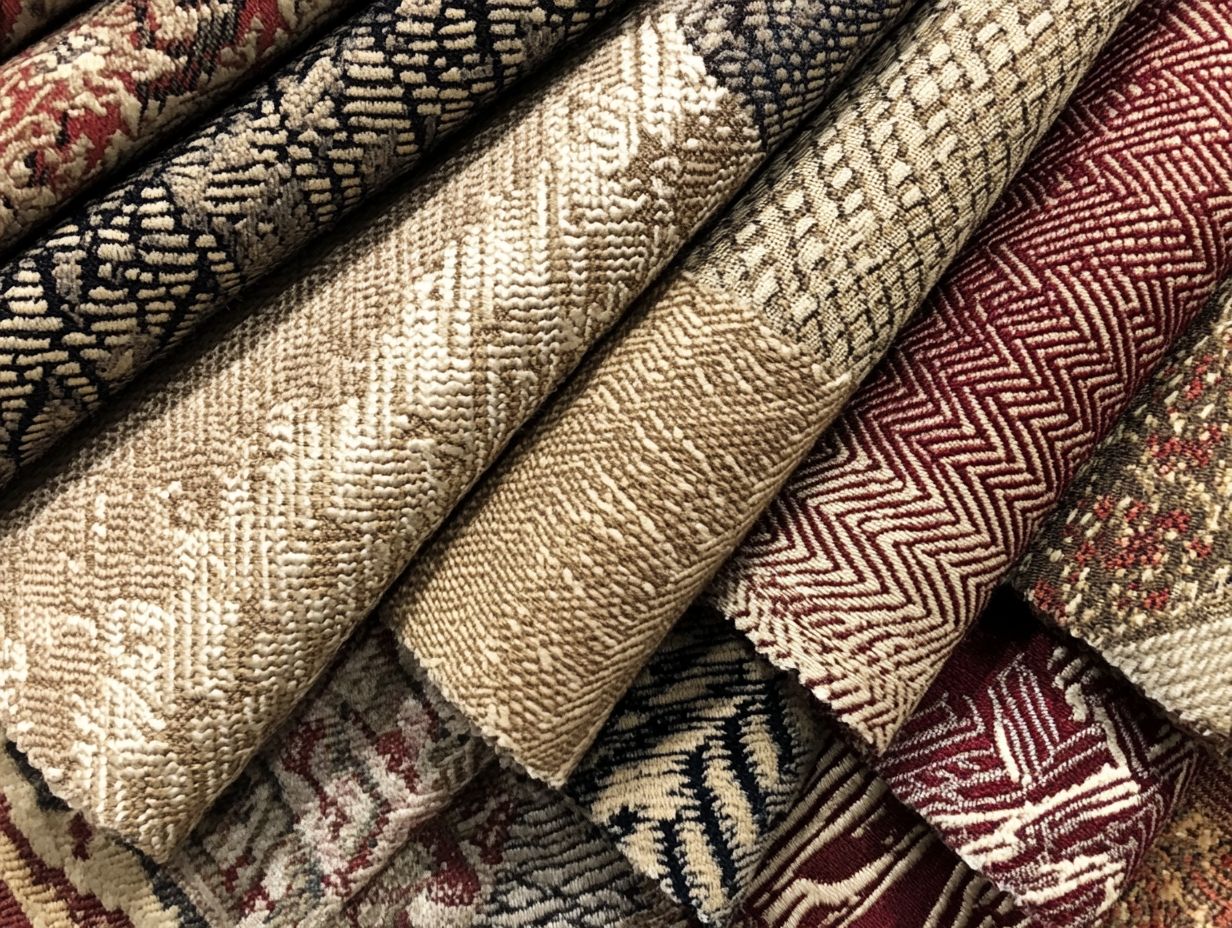
There are several types of vintage fabric weaves, including plain weave, twill weave, satin weave, basket weave, and jacquard weave. Each weave type offers unique characteristics that affect the overall aesthetic and functionality of the fabrics.
What is a plain weave fabric?
Plain weave fabric is created by weaving horizontal and vertical threads in an over-and-under pattern. This results in a simple, evenly textured fabric, forming the foundation in many fabric types.
How is twill weave fabric different from plain weave?
Twill weave fabric features a diagonal pattern formed by weaving horizontal and vertical threads over and under each other in a specific sequence. This results in a sturdy fabric with a noticeable texture, popular for durable applications.
What is the difference between satin weave and other fabric weaves?
Satin weave fabric is unique because the horizontal threads are placed over multiple vertical threads. This creates a smooth and glossy surface on one side and a duller surface on the other, resulting in a luxurious fabric ideal for formal wear and upholstery.
What is basket weave fabric?
Basket weave fabric is created by weaving horizontal and vertical threads in a crisscross pattern, giving it a checkerboard-like appearance. This weave is commonly used for heavier, more durable fabrics such as upholstery and outerwear, often showcasing unique finishes.
What is Jacquard Weave and How is it Different from Other Weaves?
Jacquard weave fabric is made on a special loom. This unique loom allows for complex patterns, resulting in beautiful designs.
People love jacquard fabric for its intricate textures. It is often found in high-end materials like brocade, a rich fabric with a raised pattern, and damask, known for its reversible design.


